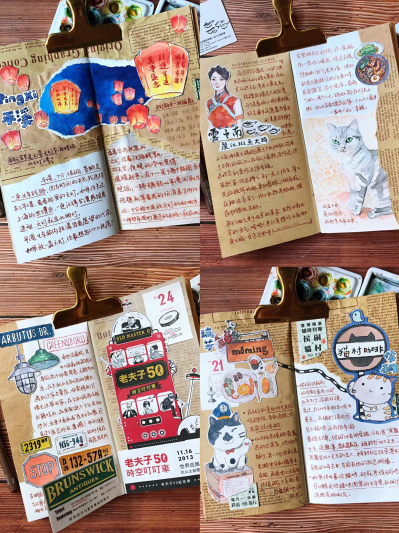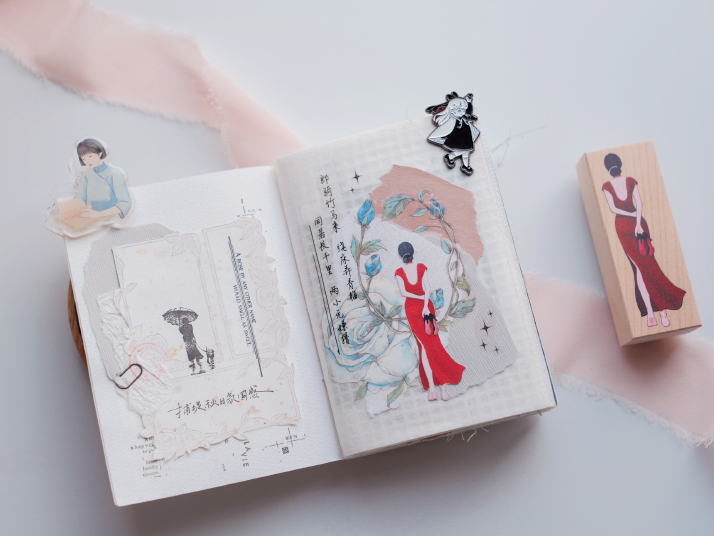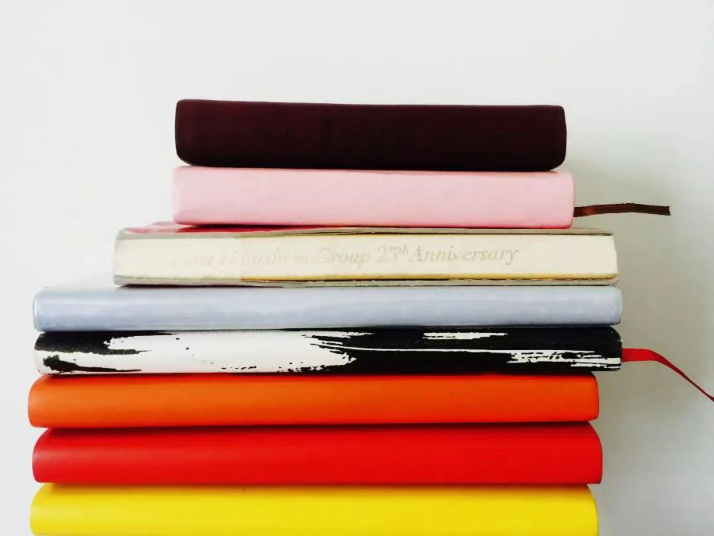| China |
| Handmade memories | |
|
|
 Liu Zhe's shouzhang documenting her travel experiences (COURTESY PHOTO)
Renowned Japanese writer Yonematsu Shiono has spent over four decades filling small notebooks with his observations. Through documenting the stories of more than 300 craftspeople, the author once articulated his belief that "things crafted by hand are art pieces imbued with an enduring human essence." Kong Qingfen can relate. The 28-year-old shouzhang enthusiast finds her connection to her past self through the handmade notebooks she created two decades ago. The term shouzhang, originating from Japanese and adopted into Chinese, refers to a portable handwritten diary that became popular in China during the 1990s. Hobbyists of this type of diary-keeping use a range of decorative elements, including stickers, silk ribbons, seals and photos to upgrade their notebooks and lend them a sense of vivaciousness—unlike a traditional diary, which mostly consists of words. Recalling her introduction to shouzhang, Kong told Beijing Review, "I think my fascination comes courtesy of my grandfather, who, during our family's Lantern Festival outings to admire the different lanterns decorating the streets, would gift his grandchildren paintbrushes and notebooks. He encouraged us to capture our favorite lantern designs. Since then, I have always maintained my shouzhang collection." The Lantern Festival, celebrated on the 15th day of the first month on the lunisolar calendar—or February 24 this year, marks the end of the Chinese New Year celebrations. The occasion is commemorated by indulging in yuanxiao (glutinous rice balls) and illuminating spherical lanterns. "I read 40 to 50 books every year and travel extensively," Kong said. "I love to record my takeaways from these physical and emotional journeys—it is an essential part of my life." The colorful moments On February 24, a shouzhang fair themed A Journey of Traditional Chinese Food, inspired by the delicacies of the Lantern Festival, was held in Beijing. More than 60 brands showcased their products, highlighting traditional Chinese elements such as local cuisines, clothing, landmarks, calligraphy and literature. Yolanda, a shouzhang brand founder, shared her experience with Beijing Review at the event, saying, "The qipao series is a bestseller here. I sourced original artwork from painters to create the products, catering to the current trend of Chinese-themed preferences among many female customers." The qipao is a traditional Chinese dress that originated in the 1920s. She proudly displayed a box of qipao-themed seals and Chinese poem tapes, a traditional Chinese art form that combines calligraphy, poetry and visual aesthetics. Liu Zhe, a freelance teacher of shouzhang making, demonstrated her creative process by crafting a Chinese New Year-themed page. She used cut-out pieces from red packets, aka hongbao—small red envelopes containing money that are traditionally given as gifts during special occasions and holidays in China, as well as shopping bags, printed Chinese dragon images, festive stickers, a train ticket and three family photos. To bring her creation to life, she used scissors, a hole punch, a Polaroid camera and glue. Liu emphasized that creating a visually appealing shouzhang requires a range of materials and thoughtful type-setting techniques. "In a shouzhang class focused on travel, for example, I instruct my students to gather tickets, receipts, family photos, decorative tapes and pens, as well as to write down their trip experiences," Liu explained. She added that she also assists students in selecting materials, creating titles, balancing images and text, coordinating colors, and addressing other design considerations. Liu customizes her teaching methods and content to accommodate a wide range of students, spanning from elementary school children to adults in their 60s, adjusting them based on unique requirements and proficiency levels. "I recommend elementary students focus on visuals rather than text. For those who are not confident in drawing, I teach how to use cut-outs from souvenirs and printed photos," Liu said. "People in their 60s often want to create a shouzhang as a 'memoir' of their lives but may not know where to begin. So I help them recall their most meaningful memories."  Yolanda's shouzhang products featuring typical Chinese elements such as the qipao and calligraphy (COURTESY PHOTO)
Stationery to stress relief With the increasing desire of young people to express themselves and immerse in creativity, numerous related business opportunities are emerging. For instance, several established stationery brands have introduced new product lines catered to shouzhang enthusiasts. In 2017, Guangbo Group, a stationery and investment corporation, unveiled a subsidiary brand called Kinbor, specializing in original and trendy shouzhang-related products. The proliferation of new brands and the revival of older brands offering more innovative and stylish products can be attributed to the intricate nature of the portable diaries and customers' willingness to invest time and money into this creative pursuit. Despite its aesthetic appeal, creating and keeping a shouzhang is a time-consuming undertaking. In 2023 alone, Liu dedicated over 600 hours to crafting notebook diaries, with the most labor-intensive page taking her 1.5 hours to complete. The reason behind her commitment is her desire to preserve moments of joy for future recollection. "Happiness is fleeting. And as time flies, people often forget about certain moments, no matter how impressive they once seemed," Liu said. "I want to keep myself refreshed by revisiting my happy memories so that whenever I feel pressured, I can 'replenish' my gratitude for life." On the other hand, for Kong, a shouzhang is a mirror for self-reflection. "Even to this day, I regularly revisit my notebook diary from middle school. There's one page about how a close friend misunderstood and betrayed me," Kong said. "It offers me insights on how to deal with relationships in the present."  Kong Qingfen’s collection of colorful and fashionable shouzhang notebooks (COURTESY PHOTO)
The shouzhang economy falls under the umbrella of the DIY (do it yourself) economy, an industry boosted by young customers' increasing demand for expressing their personalities and relieving the stress that comes with living in a fast-paced modern society. Apart from shouzhang, young Chinese are also exploring other "handmade" undertakings, leading to a surge in related programs and classes. When searching for "handmade" on the popular Chinese lifestyle and e-commerce app Xiaohongshu, courses priced between 100-800 yuan ($13.83-110.68) pop up, featuring activities like wool felting, aromatherapy candle-making, ceramics, wood carving, fan painting and scarf designing. The common thread among these programs is that they are both time-consuming and resource-intensive, and participants engage in them primarily for the experience rather than solely for the end product. "The majority of my students are young professionals," shared Zheng, a popular ceramics instructor on Xiaohongshu, who prefers to be known by her surname only, in an interview with Beijing Review. After their workday ends, they frequently devote hours to crafting ceramics. Their primary aim is to unwind and alleviate the stresses of their jobs, according to Zheng. As for future developments, the popular instructor plans to enhance her workshops by collaborating with psychologists—and even linguists. "Having a clear understanding of my customers' expectations from my classes, I intend to undergo training to improve my gestures, expressions, language use, design of class activities, visual presentation of products and my attire to deliver better outcomes in my workshops. I hold high hopes for the future of this 'handmade' industry," Zheng concluded. Copyedited by Elsbeth van Paridon Comments to zhangyage@cicgamericas.com |
|
||||||||||||||||||||||||||||
|
